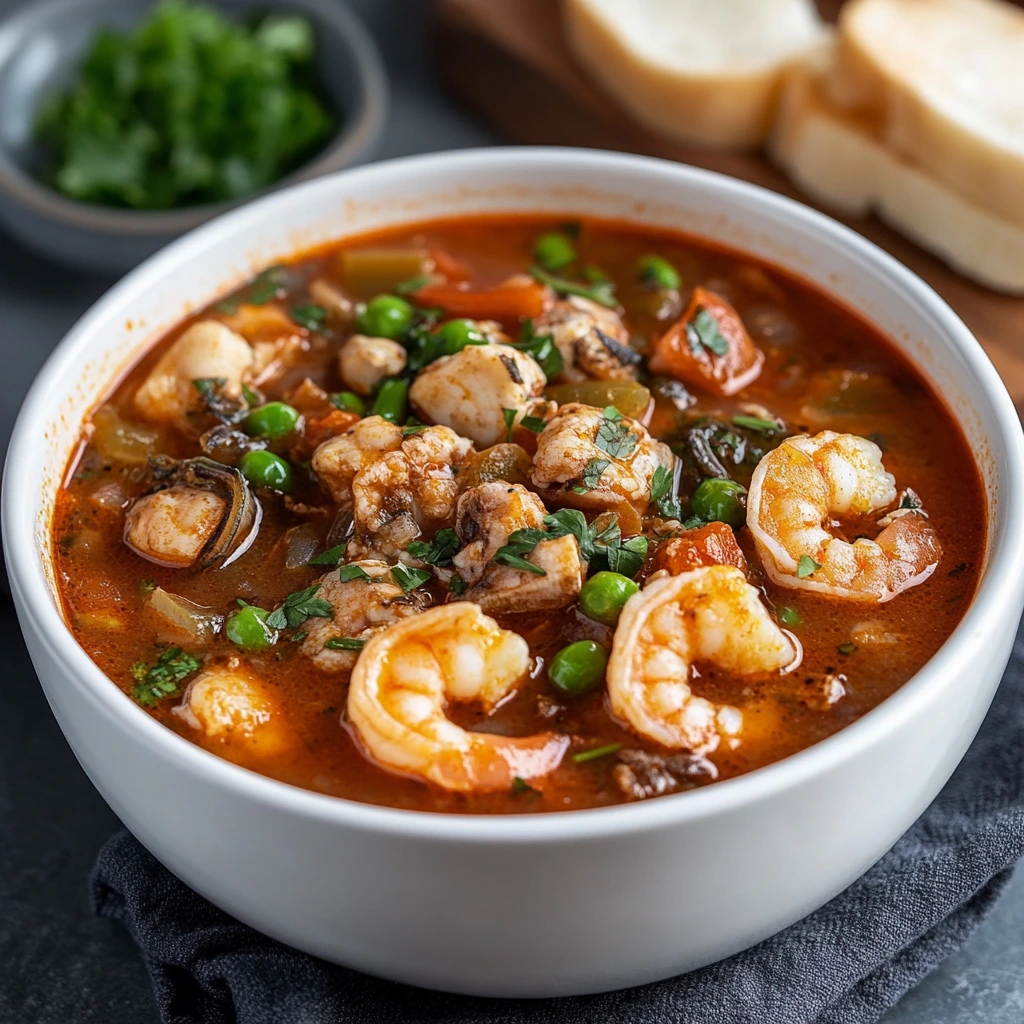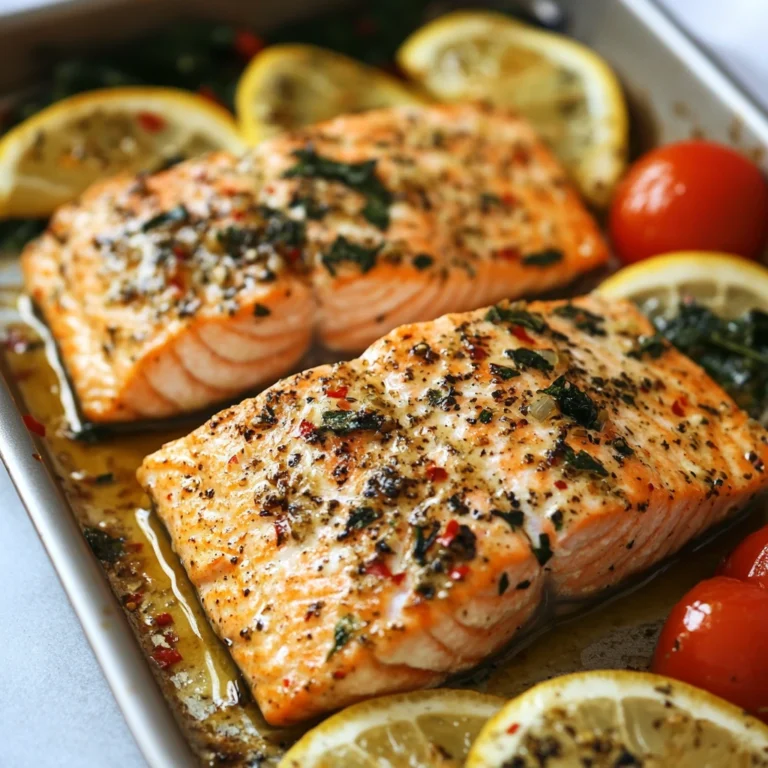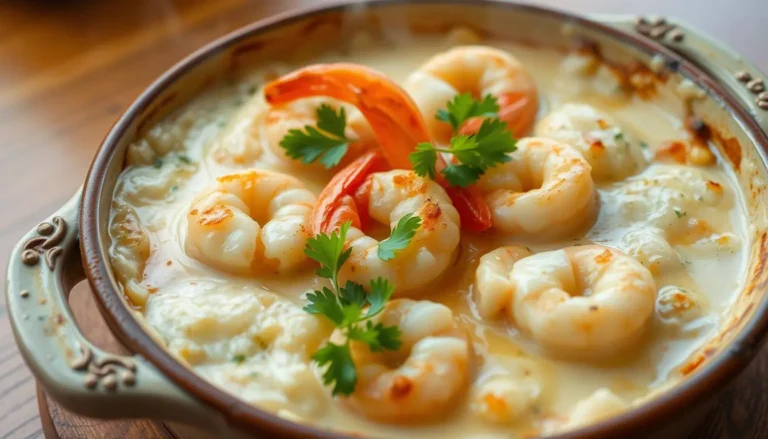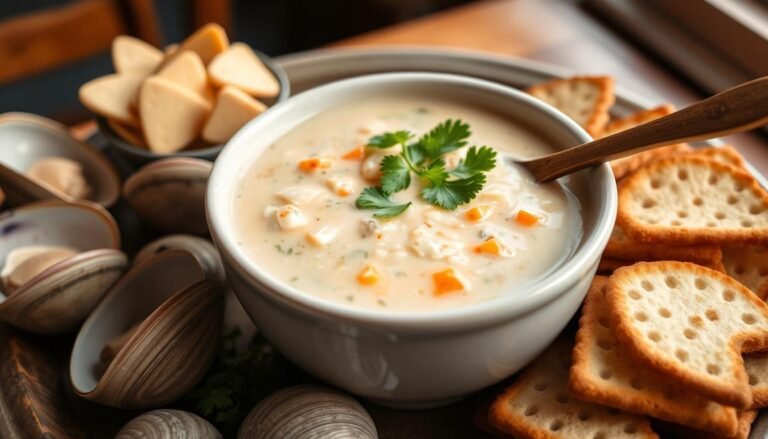Seafood Gumbo: Delicious Recipe
Authentic seafood gumbo is a cherished cornerstone of Louisiana cooking, bringing together the vibrant flavors of the Gulf Coast in one magnificent pot. This classic dish carries centuries of culinary tradition, blending French, Spanish, African, and Native American influences into a rich, deeply satisfying meal that showcases the abundant seafood of the region. Whether you’re celebrating a special occasion or simply craving a taste of New Orleans, this seafood gumbo recipe delivers an unforgettable dining experience with layers of flavor in every spoonful.
Table of Contents
Why You’ll Love This Recipe
There’s something magical about a properly made seafood gumbo. The dark, velvety roux creates a foundation of nutty, complex flavor that supports the oceanic bounty of shrimp, crab, and oysters. The Holy Trinity of Cajun cooking—bell peppers, onions, and celery—adds aromatic depth, while okra contributes its unique character and natural thickening properties.
This recipe stands out for its authenticity and depth of flavor. Unlike quick versions that cut corners, this gumbo builds flavor patiently, allowing you to taste the true essence of Louisiana cooking. The result is a perfect balance of smoky, savory, and seafood notes that transport you straight to the bayou.
What makes this recipe particularly special is its versatility. While respecting traditional techniques, it offers opportunities to customize based on seafood availability and personal preferences. The recipe also creates an impressive presentation that’s guaranteed to wow guests at your next gathering.
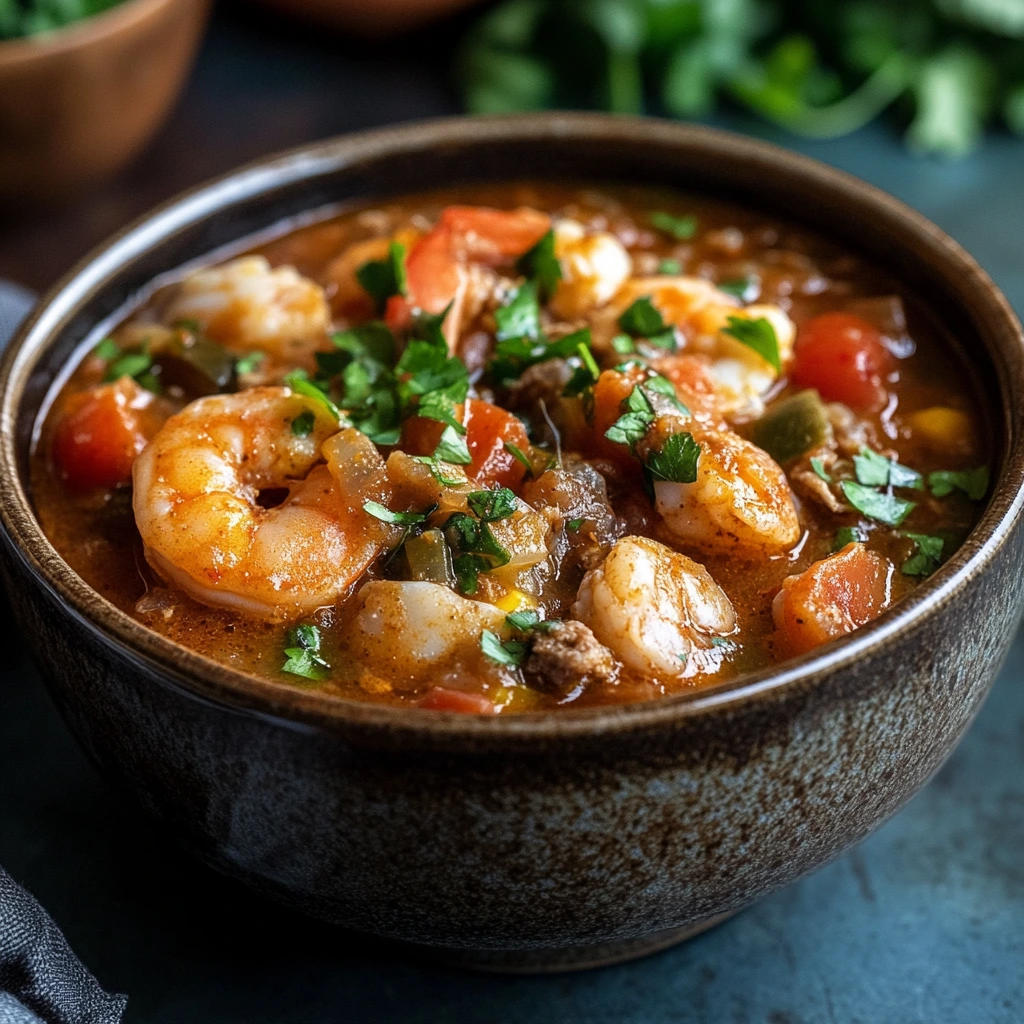
Preparation Time and Yield
- Prep Time: 45 minutes
- Cook Time: 2 hours
- Total Time: 2 hours 45 minutes
- Yield: 8-10 servings
This recipe makes a generous pot of gumbo, perfect for feeding a crowd or enjoying leftovers throughout the week. The lengthy cooking time is primarily hands-off, allowing the flavors to develop and meld beautifully. While authentic gumbo isn’t a quick weeknight meal, the investment of time delivers extraordinary results worth every minute.
Nutritional Information (Per Serving)
- Calories: 385
- Protein: 28g
- Fat: 18g
- Carbohydrates: 26g
- Fiber: 4g
- Sodium: 890mg
Keep in mind that nutritional values may vary depending on the specific seafood used and portion sizes.
Ingredients

For the Roux:
- 1 cup all-purpose flour
- 1 cup vegetable oil or bacon drippings
For the Gumbo Base:
- 2 large onions, finely diced (about 3 cups)
- 2 green bell peppers, finely diced (about 2 cups)
- 4 celery stalks, finely diced (about 1½ cups)
- 8 cloves garlic, minced
- 2 tablespoons Cajun or Creole seasoning
- 1 tablespoon dried thyme
- 2 bay leaves
- ½ teaspoon cayenne pepper (adjust to taste)
- 2 tablespoons file powder (ground sassafras leaves), divided
- 8 cups seafood stock (homemade preferred, or quality store-bought)
- 1 (14.5 oz) can diced tomatoes with juice
- 2 tablespoons Worcestershire sauce
- 1 tablespoon hot sauce (such as Crystal or Tabasco)
- 1 pound okra, sliced into ½-inch rounds
- 2 tablespoons butter
For the Seafood:
- 2 pounds large shrimp, peeled and deveined (shells reserved for stock)
- 1 pound jumbo lump crabmeat, picked over for shells
- 1 pint shucked oysters with their liquor (about 2 dozen)
- 1 pound firm white fish (such as snapper, grouper, or catfish), cut into 1-inch chunks
For Serving:
- 4 cups cooked long-grain white rice
- ½ cup green onions, thinly sliced
- ¼ cup fresh parsley, chopped
- Additional hot sauce and file powder
Step-by-Step Instructions
Making the Roux:
- In a large, heavy-bottomed Dutch oven or pot, heat the oil over medium heat until shimmering.
- Add the flour gradually, whisking continuously to prevent lumps.
- Continue cooking and stirring constantly with a wooden spoon for 30-45 minutes, until the roux reaches a deep chocolate brown color. Never leave the roux unattended, as it can burn quickly.
- Once the proper color is achieved, immediately proceed to the next step to stop the cooking process.
Building the Gumbo Base:
- Add the diced onions, bell peppers, and celery to the hot roux. Stir continuously for 5-7 minutes until vegetables begin to soften.
- Add the minced garlic and cook for another minute until fragrant.
- Stir in the Cajun seasoning, thyme, bay leaves, and cayenne pepper. Cook for 1 minute to bloom the spices.
- Gradually pour in the seafood stock, whisking constantly to incorporate the roux smoothly.
- Add the diced tomatoes with their juice, Worcestershire sauce, and hot sauce.
- Bring the mixture to a simmer, then reduce heat to maintain a gentle simmer. Cook uncovered for 1 hour, stirring occasionally.
- While the base simmers, in a separate skillet, melt the butter over medium heat and sauté the okra for 10 minutes to reduce sliminess.
- Add the sautéed okra to the gumbo and continue simmering for 30 minutes more.
- Stir in 1 tablespoon of file powder (reserve the remaining tablespoon for serving).
Adding the Seafood:
- When the gumbo base has developed its flavor, add the fish pieces and cook for 5 minutes.
- Add the shrimp and cook for 3-4 minutes until they begin to turn pink.
- Gently fold in the crabmeat and oysters with their liquor. Cook for just 2-3 minutes more until the oysters’ edges start to curl.
- Turn off the heat, cover, and let the gumbo rest for 10-15 minutes to allow flavors to meld.
- Taste and adjust seasoning if needed, adding salt, pepper, or additional hot sauce to taste.
Serving:
- Remove bay leaves before serving.
- Place a scoop of cooked white rice in the center of each bowl.
- Ladle the hot gumbo around the rice.
- Garnish with sliced green onions and chopped parsley.
- Offer the remaining file powder, hot sauce, and additional sliced green onions at the table.
Ingredient Background
Understanding the key components of seafood gumbo helps appreciate this iconic dish:
Roux: The soul of any good gumbo, a roux is simply flour cooked in fat until it develops color and flavor. For authentic gumbo, a dark chocolate-colored roux is essential, providing the distinctive nutty, complex base flavor.
The Holy Trinity: This cornerstone of Cajun and Creole cooking consists of onions, bell peppers, and celery in a 3:2:1 ratio. This aromatic foundation appears in countless Louisiana dishes.
File Powder: Ground from dried sassafras leaves, file powder adds an earthy, slightly floral flavor and serves as a thickener. Traditionally added after cooking to preserve its thickening properties.
Okra: Originally from Africa, okra came to Louisiana with enslaved people. It contributes unique flavor and natural thickening properties to gumbo.
Seafood Stock: A crucial flavor component made by simmering shrimp shells, fish bones, and aromatic vegetables. A good stock elevates gumbo from good to exceptional.
Gulf Seafood: The combination of shrimp, crab, oysters, and fish represents the bounty of the Gulf Coast. Each contributes unique textures and flavors to create a symphony of seafood goodness.
Technique Tips
Roux Patience: The roux-making process cannot be rushed. Keep the heat medium-low and stir constantly. A properly made roux should take 30-45 minutes to reach the deep chocolate color needed for authentic gumbo.
Prepare Everything First: Have all ingredients chopped, measured, and ready before beginning. Once the roux reaches the right color, you’ll need to add ingredients quickly to stop the cooking process.
Layering Seafood: Add seafood in order of cooking time—fish first, then shrimp, and finally the delicate crab and oysters. This prevents overcooking and preserves the texture of each component.
Simmer, Don’t Boil: Once seafood is added, keep the temperature low. Aggressive boiling will toughen seafood and cloud the gumbo.
Rest Before Serving: Allow the completed gumbo to rest off-heat for 10-15 minutes before serving. This resting period allows flavors to meld and seafood to finish cooking gently in the residual heat.
Alternative Presentation Ideas
Gumbo Z’herbes Inspiration: For a greener variation, incorporate chopped collard greens, kale, or spinach during the last 15 minutes of cooking the base.
Individual Serving Bowls: For an elegant presentation, serve in pre-warmed, shallow bowls with the rice molded in the center and the gumbo poured tableside.
Gumbo Shots: For cocktail parties, serve small portions in shot glasses with a single shrimp garnish for an elegant passed appetizer.
Deconstructed Presentation: Place a mound of rice in the center of the plate, arrange the seafood components artfully around it, then pour the gumbo base tableside for a restaurant-worthy presentation.
Bread Bowl: For a hearty, casual presentation, serve gumbo in a hollowed-out round loaf of crusty bread.
Freezing and Storing
Refrigerating: Seafood gumbo can be refrigerated for up to 3 days. Store in airtight containers, keeping the rice separate to prevent it from absorbing all the liquid.
Freezing Base Only: For best results, freeze only the gumbo base before adding seafood. Thaw overnight in the refrigerator, then reheat gently and add fresh seafood when ready to serve.
Freezing Complete Gumbo: If you must freeze gumbo with seafood, use within 1-2 months. The texture of shellfish may change slightly, but the flavor remains delicious. Thaw in the refrigerator overnight and reheat gently on the stovetop.
Reheating: Always reheat gumbo slowly over medium-low heat, stirring occasionally, until just heated through. Avoid boiling, which can toughen the seafood.
Serving Suggestions for Events
Mardi Gras Celebration: Serve gumbo as the centerpiece of a New Orleans-themed feast, alongside corn muffins, a simple green salad, and traditional king cake for dessert.
Seafood Feast: Include gumbo in a Gulf Coast seafood spread with cornbread, coleslaw, and bread pudding with bourbon sauce.
Winter Gathering: Gumbo’s warming qualities make it perfect for cold-weather entertaining. Serve with crusty French bread and a light appetizer like a citrus salad to balance the richness.
Family-Style Service: For casual gatherings, set up a gumbo bar with the pot at the center, surrounded by bowls of rice, sliced green onions, parsley, file powder, and hot sauce, allowing guests to customize their bowls.
Wine Pairing: Offer a crisp Sauvignon Blanc or a light Pinot Noir to complement the complex flavors of the gumbo without overwhelming the delicate seafood.
Frequently Asked Questions (FAQs)
Q: Can I make gumbo without making a roux? A: While there are shortcuts, the roux is essential for authentic flavor and color. Without it, you’d be making a seafood soup, not gumbo. The time investment rewards you with incomparable depth of flavor.
Q: Is file powder necessary? A: File powder adds distinctive flavor and thickening properties. While not absolutely essential, it contributes to authentic taste. If unavailable, increase okra slightly for thickening and add a pinch of thyme for flavor.
Q: Can I substitute frozen seafood? A: Yes, though fresh seafood provides better texture and flavor. If using frozen, thaw completely and pat dry before adding to avoid excess water in your gumbo.
Q: Why did my seafood become tough? A: Overcooked seafood becomes rubbery. Add seafood at the end of cooking, following the recommended order and timing. Remember that residual heat continues cooking even after the heat is turned off.
Q: Can I make vegetarian gumbo? A: While traditional gumbo relies on seafood or meat, vegetarian versions can be made using mushrooms, hearty vegetables, and vegetable stock. The technique remains the same, focusing on a dark roux as the flavor foundation.
Q: How thick should gumbo be? A: Authentic gumbo should be thicker than soup but thinner than stew—somewhere between the two. It should coat the back of a spoon but still flow easily when ladled.
Q: Can I use a slow cooker for gumbo? A: The roux must be made on the stovetop, but after achieving the proper color, you can transfer it with the vegetables and liquid to a slow cooker. Cook on low for 6-8 hours, then add seafood during the final 30 minutes.
Conclusion
Seafood gumbo represents the heart and soul of Louisiana cooking—a beautiful marriage of technique, history, and the abundant seafood of the Gulf Coast. While it requires time and attention, the process of creating this iconic dish connects you to centuries of culinary tradition, resulting in an incredibly rewarding dining experience that showcases the depth and complexity possible in a single pot.
The key to exceptional gumbo lies in patience: taking time to develop a proper dark roux, allowing flavors to build gradually, and treating each seafood component with respect. Following these traditional methods yields a gumbo with unmatched depth of flavor that simply cannot be achieved through shortcuts.
Whether you’re cooking for a special celebration or simply wanting to experience authentic Louisiana cuisine, this seafood gumbo recipe delivers everything you could want: complex flavors, wonderful textures, and a deeply satisfying meal that feeds both body and soul. With each spoonful, you’ll taste the rich culinary heritage of the Bayou State and understand why gumbo has remained a beloved tradition for generations.

